
Michelangelo Merisida Caravaggio, known as simply Caravaggio, was an Italian painter active in Rome for most of his artistic life. During the final four years of his life he moved between Naples, Malta, and Sicily until his death. His paintings have been characterized by art critics as combining a realistic observation of the human state, both physical and emotional, with a dramatic use of lighting, which had a formative influence on Baroque painting.

Lucia of Syracuse (283–304), also called Saint Lucia better known as Saint Lucy, was a Roman Christian martyr who died during the Diocletianic Persecution. She is venerated as a saint in the Catholic, Anglican, Lutheran, and Eastern Orthodox churches. She is one of eight women explicitly commemorated by Catholics in the Canon of the Mass. Her traditional feast day, known in Europe as Saint Lucy's Day, is observed by Western Christians on 13 December. Lucia of Syracuse was honored in the Middle Ages and remained a well-known saint in early modern England. She is one of the best known virgin martyrs, along with Agatha of Sicily, Agnes of Rome, Cecilia of Rome and Catherine of Alexandria.
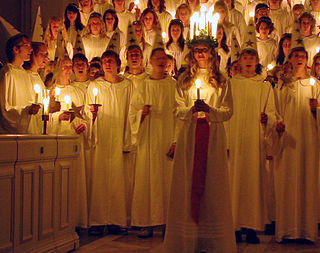
Saint Lucy's Day, also called the Feast of Saint Lucy, is a Christian feast day observed on 13 December. The observance commemorates Lucia of Syracuse, an early-fourth-century virgin martyr under the Diocletianic Persecution, who according to legend brought food and aid to Christians hiding in the Roman catacombs, wearing a candle lit wreath on her head to light her way and leave her hands free to carry as much food as possible. Her feast day, which coincided with the shortest day of the year prior to calendar reforms, is widely celebrated as a festival of light. Falling within the Advent season, Saint Lucy's Day is viewed as a precursor of Christmastide, pointing to the arrival of the Light of Christ in the calendar on Christmas Day.

The Crucifixion of Saint Peter is a work by Michelangelo Merisi da Caravaggio, painted in 1601 for the Cerasi Chapel of Santa Maria del Popolo in Rome. Across the chapel is a second Caravaggio work depicting the Conversion of Saint Paul on the Road to Damascus (1601). On the altar between the two is the Assumption of the Virgin Mary by Annibale Carracci.

The Madonna of Loreto or Pilgrim's Madonna is a painting (1604–1606) by the Italian Baroque master Caravaggio, located in the Cavalletti Chapel of the church of Sant'Agostino, just northeast of the Piazza Navona in Rome. It depicts the barefoot Virgin holding her naked child in a doorway before two kneeling peasants on a pilgrimage.

Caravaggio created one of his most admired altarpieces, The Entombment of Christ, in 1603–1604 for the second chapel on the right in Santa Maria in Vallicella, a church built for the Oratory of Saint Philip Neri. A copy of the painting is now in the chapel, and the original is in the Vatican Pinacoteca. The painting has been copied by artists as diverse as Rubens, Fragonard, Géricault and Cézanne.

Death of the Virgin (1606) is a painting by the Italian Baroque master Caravaggio depicting the death of the Virgin Mary. It is part of the permanent collection of the Musée du Louvre, in Paris.

The Madonna of the Rosary is a painting finished in 1607 by the Italian Baroque painter Caravaggio, now in the Kunsthistorisches Museum in Vienna. It is the only painting by Caravaggio that could be called a standard Baroque altarpiece.

Mario Minniti was an Italian artist active in Sicily after 1606.

The Musicians or Concert of Youths is a painting by the Italian Baroque master Michelangelo Merisi da Caravaggio (1571–1610). It is held in the Metropolitan Museum of Art, New York, where it has been since 1952. It underwent extensive restoration in 1983.

The Cerasi Chapel or Chapel of the Assumption is one of the side chapels in the left transept of the Basilica of Santa Maria del Popolo in Rome. It contains significant paintings by Michelangelo Merisi da Caravaggio and Annibale Carracci, two of the most important masters of Italian Baroque art, dating from 1600–1601.
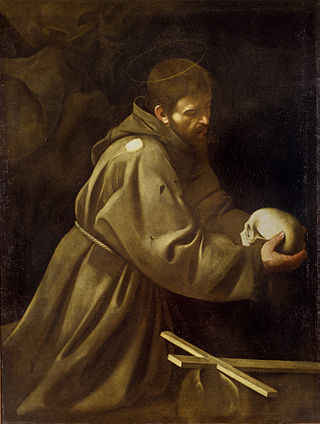
Saint Francis in Prayer is a painting from the Italian master Caravaggio, in the Galleria Nazionale d'Arte Antica in Rome.

Salome with the Head of John the Baptist (Madrid), c. 1609, is a painting by the Italian master Caravaggio in the Palacio Real, Madrid.

The Martyrdom of Saint Ursula (1610), is a painting by the Italian artist Caravaggio (1571–1610) and thought to be his last picture. It is in the Intesa Sanpaolo Collection, the Gallery of Palazzo Zevallos Stigliano, Naples.
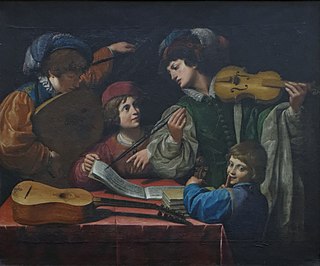
Leonello Spada was an Italian painter of the Baroque period, active in Rome and his native city of Bologna, where he became known as one of the followers of Caravaggio.

Santa Maria della Scala is a titular church in Rome, Italy, located in the Trastevere rione. Cardinal Ernest Simoni took possession of the titular church on 11 February 2017. Santa Maria della Scala is a titular church.

Saint Jerome Writing, also called Saint Jerome in His Study or simply Saint Jerome, is an oil painting by Italian painter Caravaggio. Generally dated to 1605–06, the painting is located in the Galleria Borghese in Rome.

The Cathedral of Syracuse, formally the Cattedrale metropolitana della Natività di Maria Santissima, is an ancient Catholic church in Syracuse, Sicily, the seat of the Catholic Archdiocese of Siracusa. Its structure is originally a Greek doric temple, and for this reason it is included in a UNESCO World Heritage Site designated in 2005.
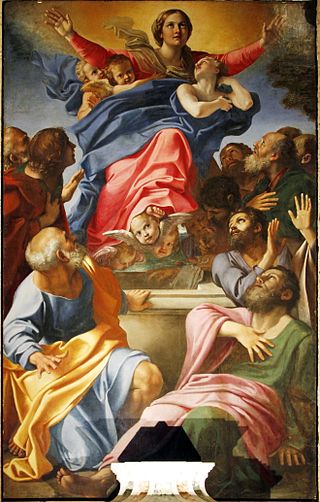
The Assumption of the Virgin by Annibale Carracci is the altarpiece of the famous Cerasi Chapel in the church of Santa Maria del Popolo in Rome. The large panel painting was created in 1600–1601. The artwork is somewhat overshadowed by the two more famous paintings of Caravaggio on the side walls of the chapel: The Conversion of Saint Paul on the Road to Damascus and The Crucifixion of Saint Peter. Both painters were important in the development of Baroque art but the contrast is striking: Carracci's Virgin glows with even light and radiates harmony, while the paintings of Caravaggio are dramatically lit and foreshortened.
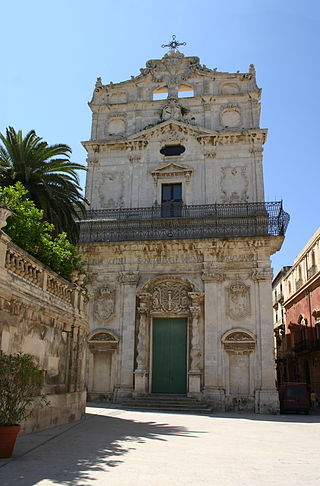
Santa Lucia alla Badia is a baroque-style, Roman Catholic church, now deconsecrated, located on the south corner of the piazza duomo, located to the south of the facade of the Cathedral of Syracuse), located in the island of Ortigia, the historic city center of Siracusa in Sicily, Italy. The church building and adjacent former monastery is now used for special exhibitions and functions.





















